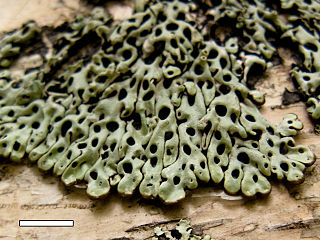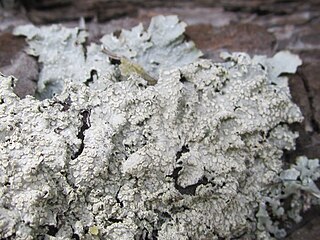
Parmelia is a genus of medium to large foliose (leafy) lichens. It has a global distribution, extending from the Arctic to the Antarctic continent but concentrated in temperate regions. There are about 40 species in Parmelia. In recent decades, the once large genus Parmelia has been divided into a number of smaller genera according to thallus morphology and phylogenetic relatedness.

Hypogymnia is a genus of foliose lichens in the family Parmeliaceae. They are commonly known as tube lichens, bone lichens, or pillow lichens. Most species lack rhizines that are otherwise common in members of the Parmeliaceae, and have swollen lobes that are usually hollow. Other common characteristics are relatively small spores and the presence of physodic acid and related lichen products. The lichens usually grow on the bark and wood of coniferous trees.

Menegazzia is a genus of lichenized fungi containing roughly 70 accepted species. The group is sometimes referred to as the tree flutes, honeycombed lichens, or hole-punch lichens. The most obvious morphological feature of the genus is the distinctive perforations spread across the upper side of the thallus. This makes the group easy to recognise, even for those not particularly familiar with lichen identification.

Esslingeriana is a fungal genus in the family Parmeliaceae. The genus is monotypic, containing the single foliose lichen species Esslingeriana idahoensis, commonly known as the tinted rag lichen. It is found in northwestern North America.
Hypotrachyna lueckingii is a species of corticolous (bark-dwelling), foliose lichen in the family Parmeliaceae. It is only known to occur at high elevations on the Cordillera de Talamanca in Costa Rica.
Relicina colombiana is a species of saxicolous (rock-dwelling), foliose lichen in the family Parmeliaceae. Found in high-elevation páramo of the Eastern Cordillera in Colombia, it was described as new to science in 2011.
Hypogymnia congesta is a rare species of foliose lichen in the family Parmeliaceae. Found in China, it was formally described as a new species in 2003. The lichen grows on the bark and wood of conifers and bamboo. Hypogymnia congesta has a brown to brownish-grey foliose thallus measuring up to 8 cm (3.1 in) long or broad, with a cartilage-like texture. The lichen is chemically distinct, containing physodic acid and virensic acid; the latter substance is otherwise unknown from genus Hypogymnia.
Punctelia subpraesignis is a species of foliose lichen in the family Parmeliaceae. It occurs in Mexico, South America, and East Africa, where it grows on bark and on rocks. Major characteristics of the lichen that distinguish it from other Punctelia species include the C+ and KC+ rose spot tests of the medulla, ascospores that are smaller than 20 μm, and unciform (hooklike) conidia.

Punctelia perreticulata is a widely distributed species of foliose lichen in the family Parmeliaceae. It occurs in Mediterranean Europe and Russia, North America, South America, Australia, and New Zealand, where it grows on rocks, bark, or wood. Its main distinguishing features are its thallus surface, marked with many shallow depressions, grooves, or pits, and sorediate pseudocyphellae. The lower side of the thallus is ivory to tan towards the centre and the major secondary metabolite in the medulla is lecanoric acid. A lookalike species with which it has been historically confused is Punctelia subrudecta; this lichen can be distinguished from Punctelia perreticulata by the texture of the thallus surface, or, more reliably, by the length of its conidia.

Hypogymnia krogiae, commonly known as the freckled tube lichen, is a species of foliose lichen in the family Parmeliaceae. Found in North America, it was described as a new species in 1973 by Karl Ohlsson. The type specimen was collected near Cheat Bridge, West Virginia by Mason Hale in 1956.
Hypogymnia pruinoidea is a species of foliose lichen in the family Parmeliaceae. Found in China, it was formally described as a new species in 2012 by Xin-Li Wei and Jiang-Chun Wei. The type specimen was collected from Mt. Taibaishan (Shaanxi) at an elevation of 2,800 m (9,200 ft), where it was found growing on the trunk of Abies. It is only known to occur at this location, a cool and moist montane environment supporting lichen-rich forests and woodlands. The species epithet refers to the pruinose upper thallus surface and lobe tips.
Hypogymnia capitata is a species of foliose lichen in the family Parmeliaceae. Found in high-elevation conifer forests in Sichuan Province, China, it was described as a new species in 2014. The lichen is characterized by its capitate terminal soralia, brownish lobes with white cavities, and the presence of olivetoric acid. This lichen is distinguished from similar species by its specific morphological, chemical, and habitat characteristics.
Hypogymnia nitida is a species of foliose lichen in the family Parmeliaceae. It has a glossy dark brown upper surface and a strongly wrinkled, convoluted lower surface. Found in China, it was described as a new species in 2014.
Hypogymnia tenuispora is a rare species of foliose lichen in the family Parmeliaceae. Found in China's Yunnan province, it is characterised by its uniquely narrow ascospores and crowded lobes, which help distinguish it from other similar Hypogymnia species.
Heterodermia fragmentata is a species of corticolous (bark-dwelling) foliose lichen in the family Physciaceae. It occurs in Sri Lanka.

Peltigera cinnamomea, commonly known as the cinnamon-pelt lichen, is a muscicolous (moss-dwelling), leafy lichen in the family Peltigeraceae. The Canadian lichenologist Trevor Goward formally described the species in 1995. The lichen is found in northwestern North America's forested regions, particularly in the unique montane and subalpine forest communities of the northern Rocky Mountains. Peltigera cinnamomea grows under prolonged snow cover, surviving well into spring. This trait distinguishes it from many other Peltigera species in similar North American forest ecosystems.

Peltigera castanea is a species of terricolous and muscicolous, foliose lichen in the family Peltigeraceae. Described as a new species in 2003, it is part of the taxonomically challenging species complex centred around Peltigera didactyla. Recognised based on phylogenetic studies that highlighted its unique genetic markers, P. castanea is distinguished by its dark, chestnut-coloured upper surface, which inspired its vernacular name, chestnut pelt lichen. Its known distribution includes North America, Asia, Europe (Estonia), Greenland, and the Antarctic. The conservation status of Peltigera castanea varies regionally, from being critically imperiled in British Columbia and Yukon to critically endangered in Estonia due to significant habitat degradation and restricted population size.
Leioderma cherokeense is a species of corticolous (bark-dwelling), foliose lichen in the family Pannariaceae.

Tuckermannopsis orbata, commonly known as the variable wrinkle lichen, is a species of foliose lichen in the family Parmeliaceae. It is a small cetrarioid lichen, an informal growth form category that denotes lichens with erect, foliose thalli, and apothecia and pycnidia on the margins of the ruffled lobes. Tuckermannopsis orbata is found in Asia and North America, growing primarily on the wood and bark of mostly birch and coniferous tree branches and twigs.
Ramboldia gowardiana is a species of corticolous (bark-dwelling), crustose lichen in the family Ramboldiaceae. First discovered in 2003 in Montana, United States, it typically appears as a grayish or greenish crust on tree bark, particularly on conifers like pines and firs. The lichen is characterised by its small, bright red to orange-red reproductive structures (apothecia) visible on its surface. R. gowardiana is found in dry, temperate forests from Alaska to California, often at elevations between 300 and 1,400 meters. Initially classified in a different genus, it was reclassified as Ramboldia in 2008 based on genetic studies. This lichen is part of the biodiversity of the Pacific Northwest region of North America.









